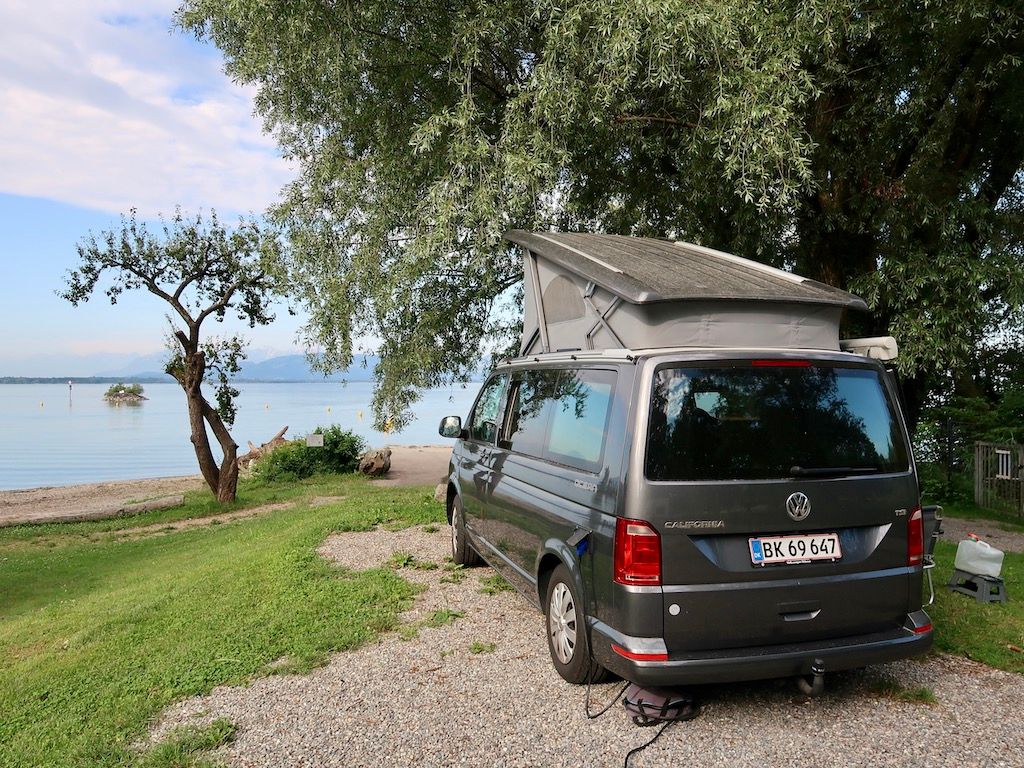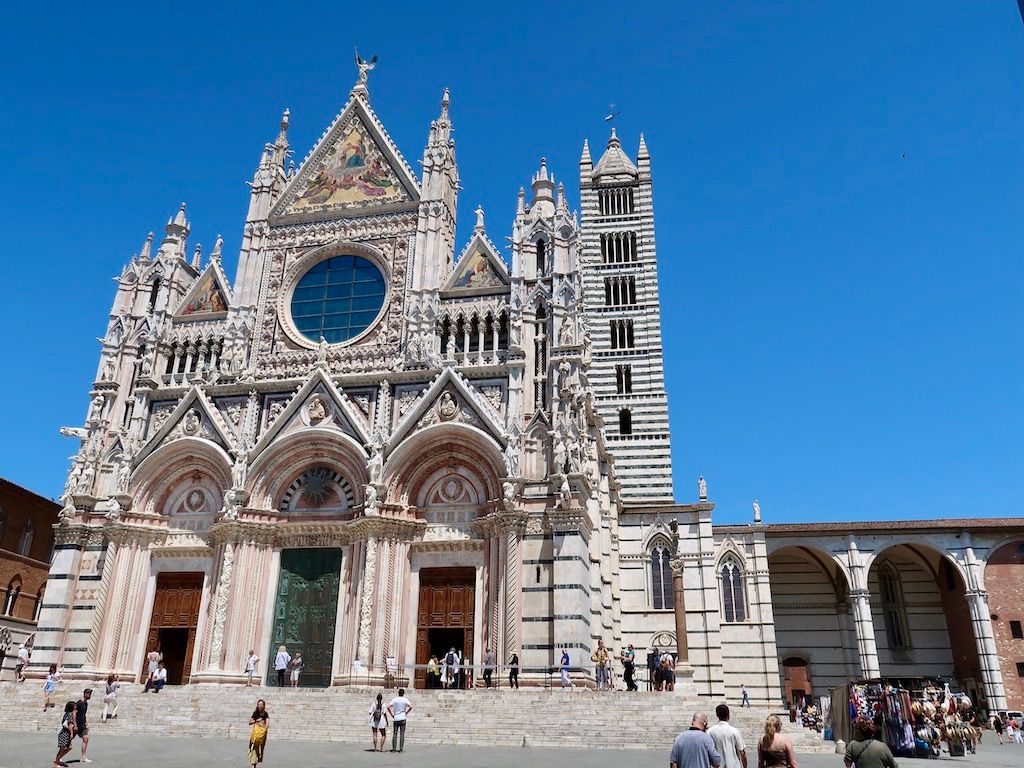The cathedral in Siena.
Italy
Before the trip, we got a lot of good advice about "what we shouldn't miss" from Italians and Danish travellers to Italy. The long country has more to offer than you can see in two months, so we had to choose.
After one night in Kassel and one in Lindau on Lake Constance with views of mountain peaks and music on alpenhorn, we reached Italy via the San Bernardino Tunnel.
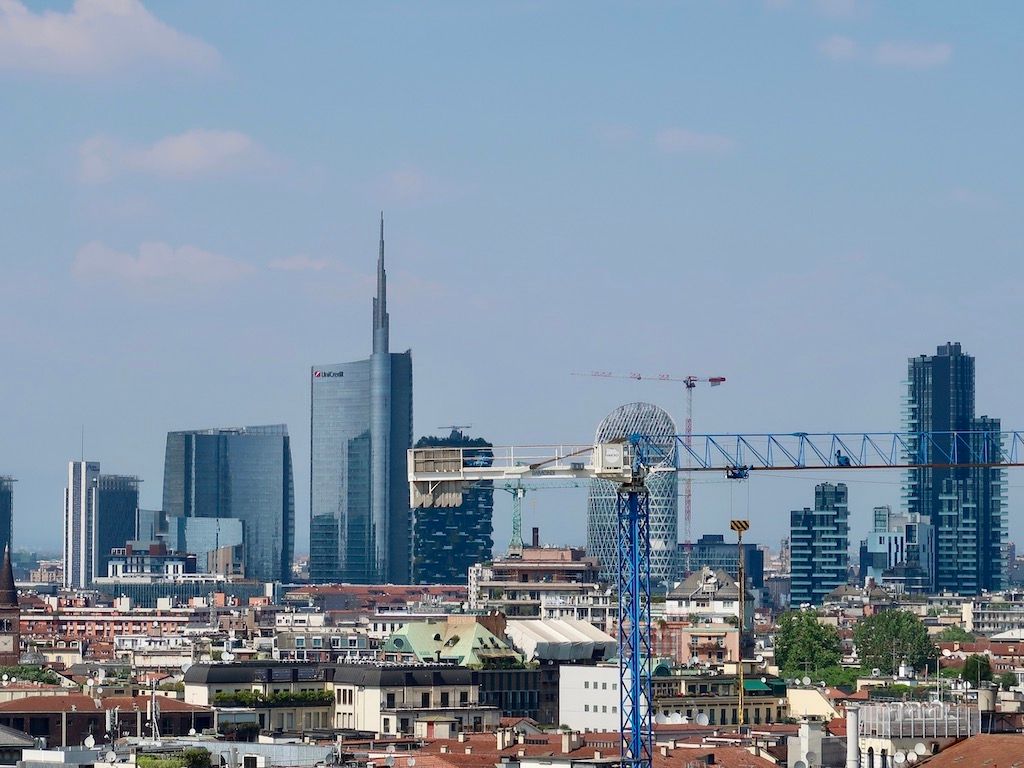
Milan and its surroundings
Our first stop was Milan, where we were warmly welcomed by the retired doctor Antonella, whom we had interviewed in Odense. We also got to know the young landscape architect Laura and interviewed her. With Antonella as an informed guide, we had great experiences in and around Northern Italy's multicultural capital. See Antonella here and Laura here.
Milan has developed from an industrial city to a city of knowledge and design. This can be seen in the streets around the stately building in glass and steel Galleria Vittorio Emanuele II named after the country's first monarch, who rides a bronze horse in the cathedral square. Here, Italian fashion houses such as Armani, Prada and Gucci are represented side by side with foreign brands such as Louis Vuitton, Mont Blanc and Lego. The price tags are small and the prices high, we noticed on a walk surrounded by stylish people and streamlined sports cars. A shiny red Ferrari was a favoured background for selfies.
The roof of the impressive Gothic cathedral, where Antonella's father had been organist, provided a fine view across the city's old, low rise centre towards its new skyline, where buildings by internationally renowned architects tower.
The multi-artist Leonardo da Vinci personifies the dynamism and creativity that characterized city-states of Northern Italy during the Renaissance. The National Science and Technology Museum is named after the master and exhibits models of his sketches for buildings, planes, parachutes, submarines, etc. Leonardo's painting The Last Supper in the monastery of Santa Maria delle Grazie is an example of the movement from medieval flat painting towards the central perspective, which includes the viewer and thus reflects the beginning liberation of the individual.
Antonella invited us on trips to the historic city of Bergamo and the attractive lakes Lago di Como, Lago Maggiore and Lago d'Orta with villas and gardens laid out by wealthy people from home and abroad. A boat trip brought us to Isola Bella in Lago Maggiore, with the noble Borromeo family's palace and pyramid-shaped baroque garden. We also saw Sacro Monte di Orta, where groups of sculptures in twenty small chapels begun in the 16th century recount the life story of Francis of Assisi.
The visit to La Macina an agro turismo created in carefully renovated farm buildings by Antonella's acquaintances was an aesthetic and culinary experience. They gave us a tour, presented the visions for their project and served an exquisite meal of local produce.
Before leaving Milan, we turned twice around ourselves with a heel on the mosaic bull in the floor of the Galleria Emanuele for luck and the opportunity to return.
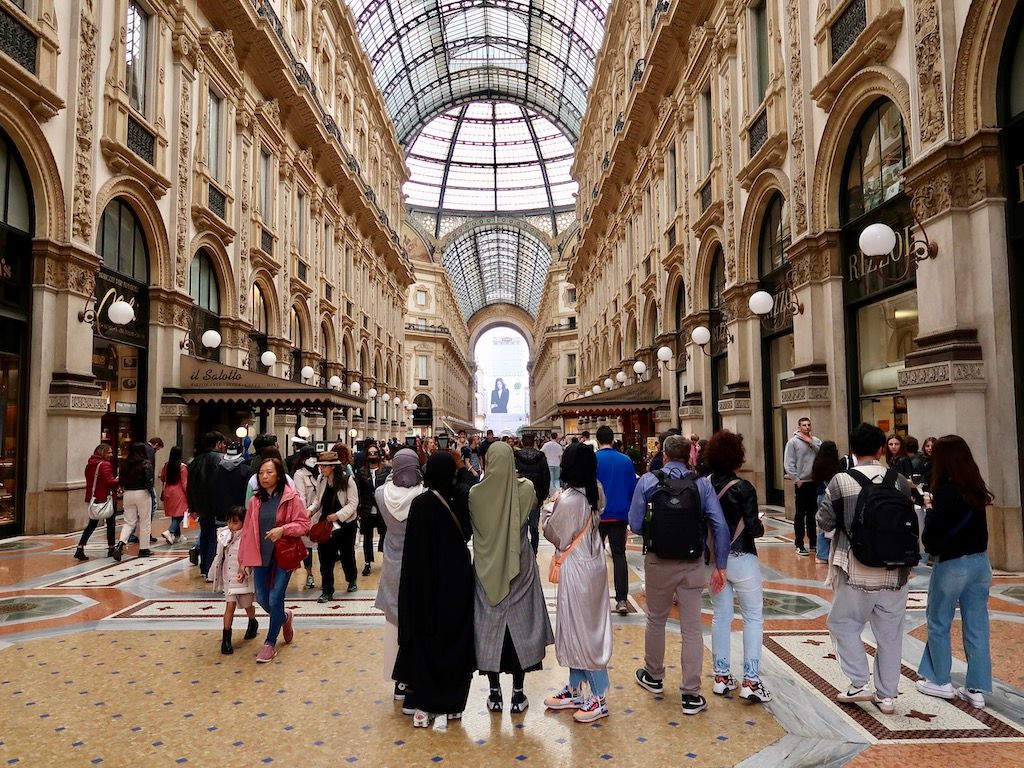
Hans Christian Andersen in Sestri Levante
"Then we are brothers," said the host at the campsite in Sestri Levante, when we told him that we live in Hans Christian Andersen's city of birth Odense. Andersen paid a short visit here in 1833 during the Grand Tour that inspired his debut novel “The Improvisatore”. The visit left a lasting mark on the city. It now has a Bay of Fairy Tales as well as a yearly festival, a street and a school named after Andersen.
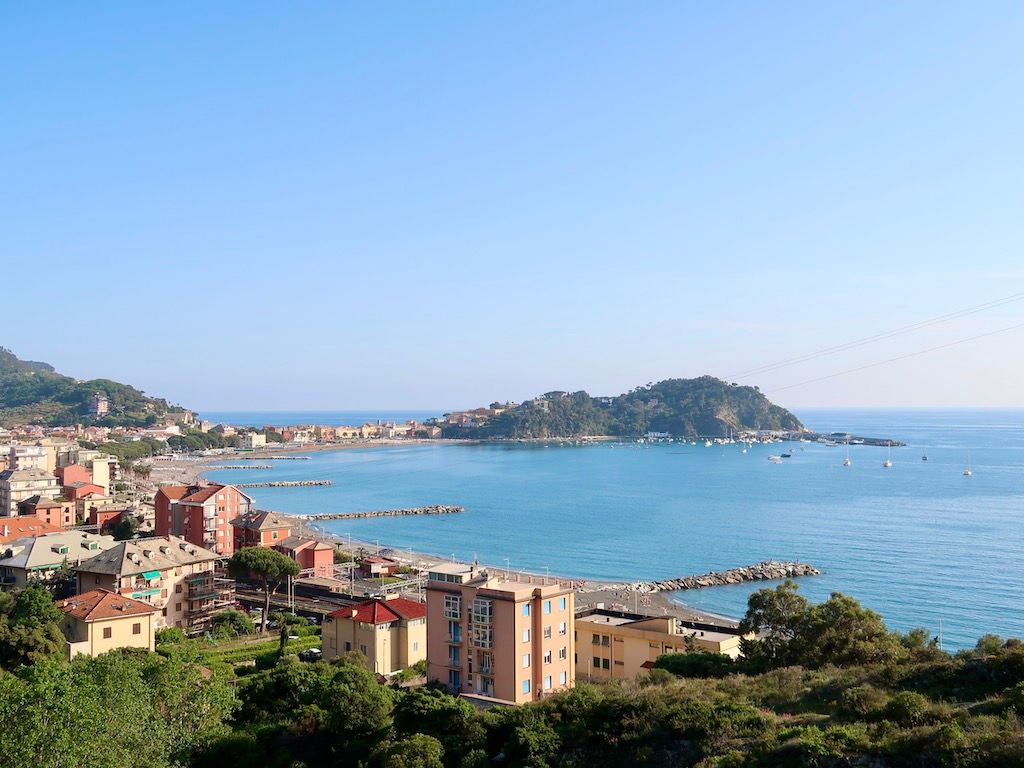
The National Park Cinque Terre
Like the poet, we noted that Sestri Levante is beautifully situated between two bays. It is located a little north of the Cinque Terre and became our base for exploring the national park with the five towns balancing on the rocky coast. We took the railway and in a couple of days visited Riomaggiore, Manarola, Corniglia, Vernazza and Monterosso. They each have their own character, but are overall picturesque variations on the themes harbour, church, monastery, castle and lime washed houses. They are surrounded by fields on terraces protected by stone walls with no mortar so that water can penetrate.
A hike along the farmers' path between Vernazza and Monterosso past vineyards, orchards, mighty cacti and agaves gave fine views and the feeling of hard work in a hot climate. A middle-aged local told us that his grandfather had fished and grown wine, but now he let a young man use the family's fields because it was less strenuous and more profitable to sell ice cream to the many tourists.
On our way through Italy, we enjoyed the country's delicious ice cream, the lemon liqueur Limonetto, Aperol Spritz with sweet orange slices and finely spiced pasta dishes with a glass of local wine and a tiny cup of strong espresso.
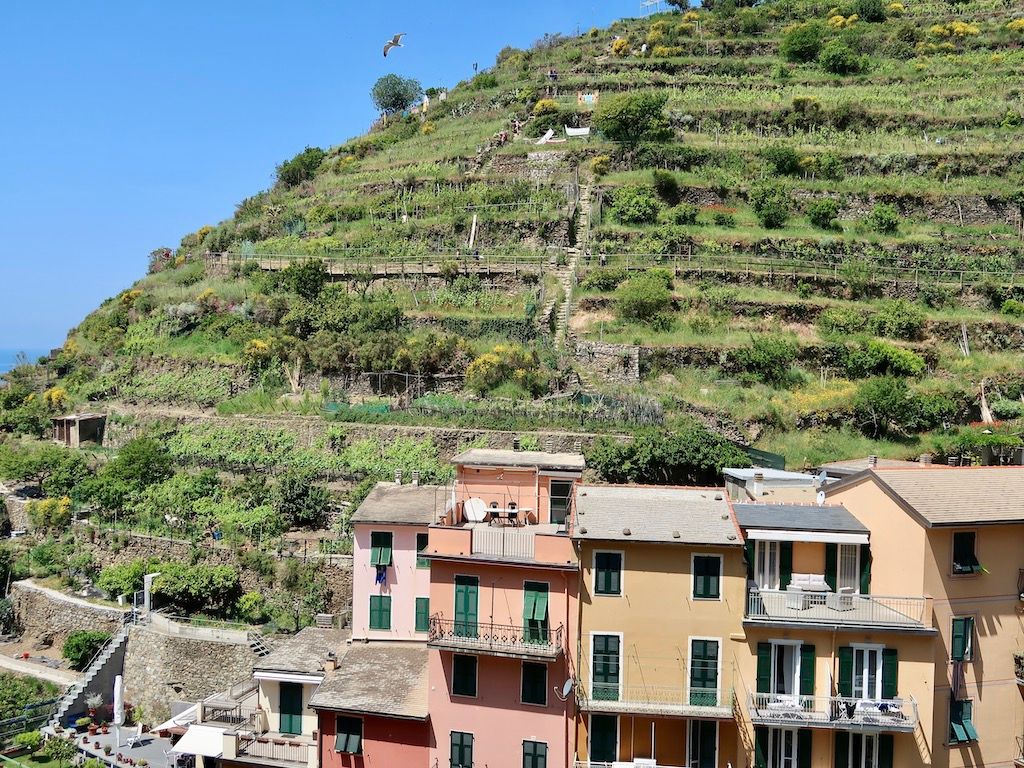
Past and present in Siena
Siena flourished until the plague hit in 1348. Now it is a well-preserved medieval town with red brick buildings in beautiful squares and narrow streets. A man explained that there are rules about what changes homeowners are allowed to make, and this pleased him.
Siena's Gothic town hall, begun at the end of the 13th century, seems both foreign and familiar, when you come from Denmark. It inspired the architects behind Copenhagen's and Odense's town halls around six centuries later. During Siena's annual Palio, the clam-shaped town hall square is transformed into an arena for horse racing. We saw the City Museum in the town hall, but due to a corona-limited ticket supply we did not reach the top of the tower.
The plague meant that the original plans to build the world's largest cathedral in Siena remained a beautiful Gothic-Romanesque torso with stripes of black and white marble. The church honours Virgin Mary. Its floor is adorned by mosaics with mythological and biblical motifs, the reliefs of the pulpit tell the life story of Christ.
Opposite the cathedral is Santa Maria Della Scala, a mighty more than a thousand-year-old hospital converted into a modern cultural centre. The vaulted pilgrims' hall has frescoes with scenes from the building's history as a refuge for pilgrims, orphans and the sick. The centre is introduced in a video near the entrance. In addition to the building complex itself, we saw children's art and a collection of classical art, which travellers on their Grand Tour of Europe in the late 18th century visited in the nearby Palazzo Spannocchi.
Walking on a Saturday, we saw a vegan demonstration for animal welfare, a samba orchestra at an event for red-nosed hospital clowns, a bicycle race for children cheered by their committed families and a traveling funfair in the Medici fort. – The medieval city was buzzing with contemporary life.
In Tuscan Wine School, winemaker Mattia gave a knowledgeable and humorous introduction to Italian wines with tastings of six Tuscan ones served with local hams and cheeses. "If you forget the fun, you forget the human side of wine," he said.
The pilgrimage route Via Francigena went from the cathedral in Canterbury, England, through present-day France, Switzerland and Italy to Rome, passing Siena from Porta Camollia to Porta Romana. It contributed to the city's prosperity in the Middle Ages and is being revived for hikers, cyclists and horse riders.
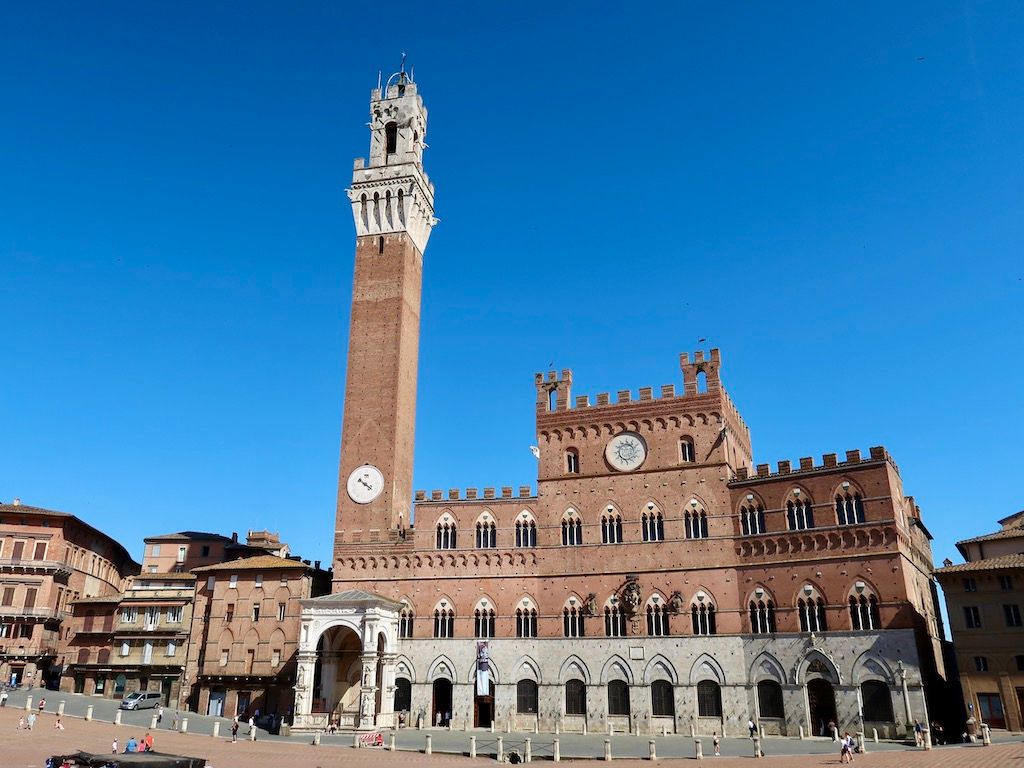
Relics of history in Rome
There is an overwhelming amount of sights in Rome, history is present everywhere. We spent a week there in 2012 revisited some places, skipped others and found new ones this time. Central Piazza Navona with fountains, churches, palaces and lots of people was a great start. The nearby Palazzo della Sapienza was formerly the University of Rome, and the Norwegian-Danish writer Ludvig Holberg studied here in the early 18th century. The twisted tower of the University Church inspired the architect Lauritz de Thurah for the spire of Our Savior's Church in Copenhagen.
Peaceful Piazza Farnese houses the French Embassy. Lively Piazza Campo de' Fiori a vegetable and flower market. The Pantheon, with its impressive concrete domed roof, is an ancient temple for all gods, which was transformed into a church, and later into a burial place for the kings of Italy. Guarded Palazzo Chigi and Palazzo Montecitorio house Italy's prime minister and the Chamber of Deputies respectively. Piazza del Campidoglio on the Capitol, the smallest and tallest of Rome's seven hills, is the town hall square, where brides and grooms pose for photographs.
In Via Sistina near Piazza Barberini lived both the Danish sculptor Bertel Thorvaldsen and the poet Hans Christian Andersen for a period in the 1830s. They could take the Spanish Steps to Caffé Greco, where waiters in white tie now serve expensive coffee in historic surroundings. In the Piazza del Popolo, orange-clad Hare Krishna devotees spread their happy message when we were there. Piazza Venezia at the opposite end of Via del Corso is dominated by the pompous marble monument to King Vittorio Emanuele, the square marks the transition between modern and ancient Rome.
The Roman Forum was the centre of political, legal, commercial, religious and social life of the Roman Empire. The swampy area was drained by Cloaca Maxima in the 5th century BC. This created the base for ambitious building projects, until decay set in around a thousand years later, helped by wars, fires and earthquakes. Wild plants spread and the area was used for grazing. In the Middle Ages, ruins were converted into churches, and in the Renaissance, they were used as quarries. The excavation of the ancient buildings began in the 1800s, and the search for historical insight is still ongoing. We walked for a whole day between the Forum and Palatine Hill temples, churches, triumphal arches, ruins and reconstructed houses. Didn't understand everything, but got an impression of the rise, decay and rediscovery of a great civilization.
The Colosseum is the largest preserved amphitheatre in the Roman world, which Emperor Vespasian began building in 72 after the birth of Christ and his sons Titus and Domitian completed. It had room for about 60,000 spectators placed by rank, so that the emperor was near the stage and the plebs at the back. The audience witnessed deadly gladiator fights, hunts for wild animals, theatrical naval battles, etc. The Colosseum, like the Roman Forum, underwent changing functions and decay until it was recreated in the 19th century. We visited the breath-taking theatre together with many tourists and children in their school uniforms.
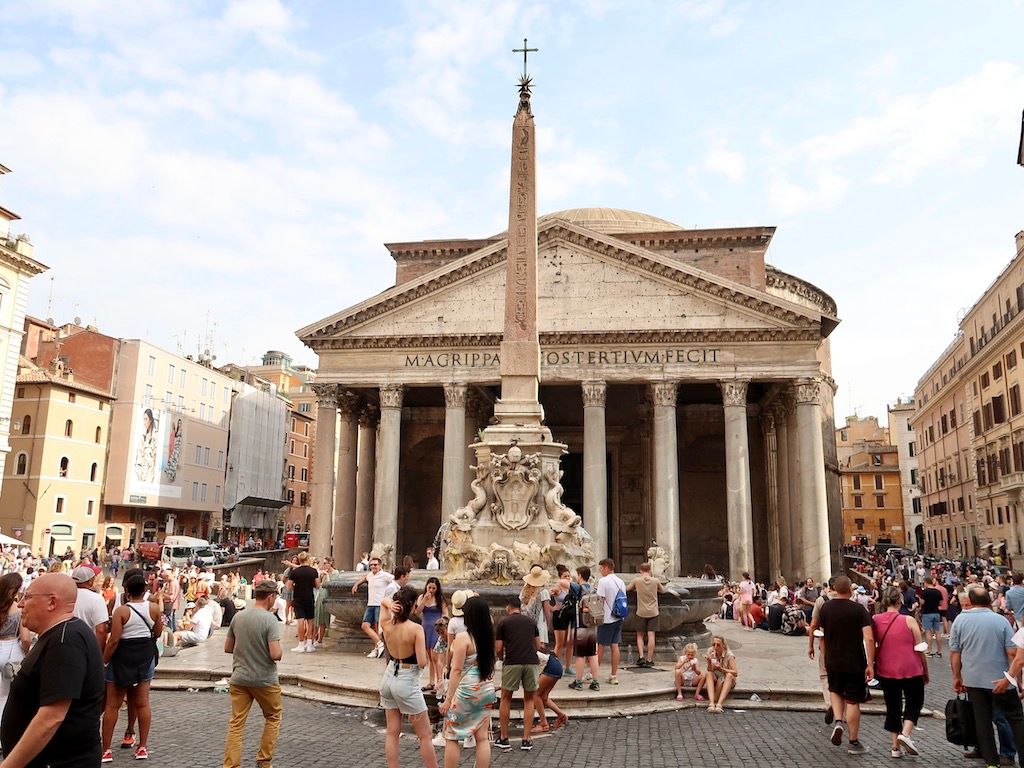
Pope Francis in the Vatican
When we crossed the border of the small, independent Vatican City State, all backpacks were checked, and we had to deposit our water bottles. We came to hear Pope Francis' weekly address from a window to a large gathering in St. Peter's Square. The Pope spoke Italian, but we understood the devout enthusiasm of the audience. Germans, Americans and Hungarians told us that this was an experience of a lifetime. In the enormous room of St. Peter's Basilica, we noticed the descent to the apostle's tomb under the altar, his bronze statue, Michelangelo's Pieta and Thorvaldsen's tomb monument for Pope Pius VII.
With Frederico Fellini's film La Dolce Vita and Anita Ekberg's nocturnal bathing scene in mind, we, like many other travellers to Rome, offered a coin to the Trevi Fountain hoping to return to the Eternal City.
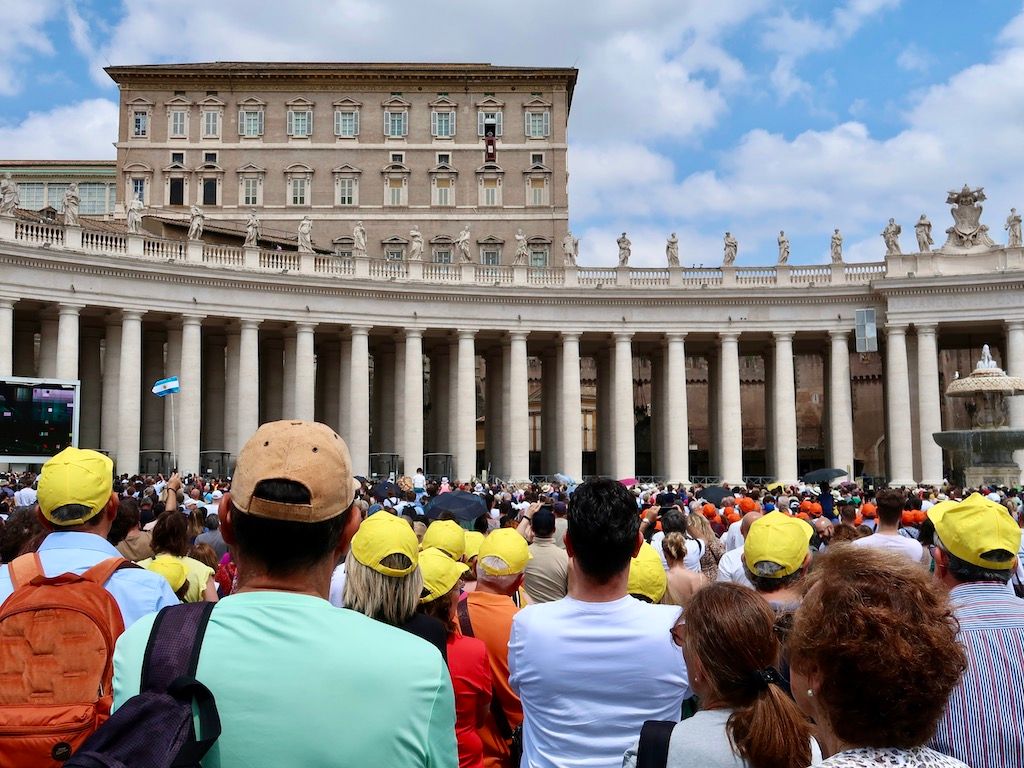
Mt. Vesuvius, Herculaneum and Pompeii
The explosive eruption of the volcano Vesuvius in 79 came as a surprise to the residents of the nearby towns of Herculaneum and Pompeii, which were covered in a thick layer of volcanic ash and sand. The dramatic events that claimed the lives of over 2,000 people are described by the eyewitness Pliny the Younger. Herculaneum was found in 1599 and forgotten again. In the 18th century, both towns were rediscovered, they were partially excavated in the following centuries, and research into their history is still going on.
We visited both the relatively well-preserved Herculaneum and the bigger, but harder-hit Pompeii. Together they provide a snapshot of life in Roman provincial towns in the first century. We got an impression of homes, shops, gardens, theatres, temples, works of art and a brothel, where the frescoes on the walls presented a varied erotic menu. Plaster casts in cavities shaped by the bodies of dead people made the tragedy present across centuries.
We took a bus and hiked the last bit to Vesuvius' crater, which is covered in solid lava. The most recent outbreak occurred in 1944, a future one will threaten approximately 3 million people in and around Naples. We met a local, who told us that the volcanic activity is closely monitored, and added, "The volcano is free and can do what he wants, we are not afraid, but we will have to run!"
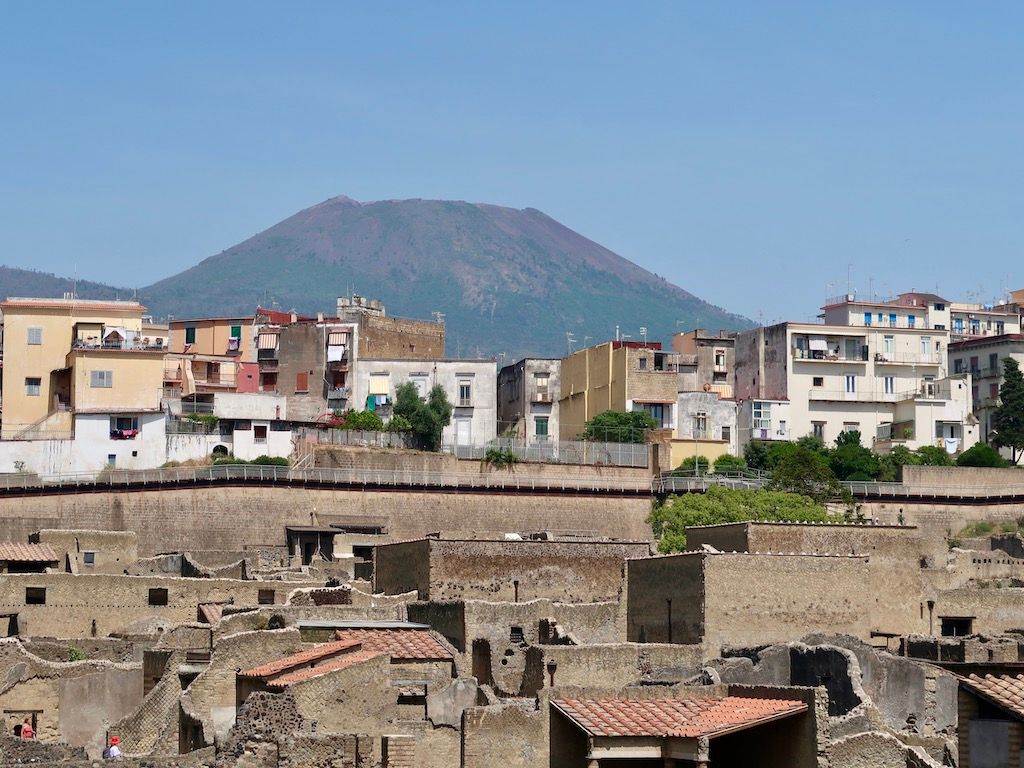
Sunset at Mt. Etna
Based in Catania, we got a guided sunset tour to the Sicilian volcano Mt. Etna, which is Europe's highest and one of the world's largest. An eruption in 1699 reached large parts of Catania, since 1971 the volcano has been very active.
Our guide Emanuele from Etna Experience, who had written a Ph.D. on volcanoes, was an excellent communicator. He showed us, among other things a dead crater, a lava cave formerly used for ice storage, a house buried to the roof as well as barren landscapes covered in lava. The lava flows are destructive, but they move so slowly that people can get away, and the affected areas are gradually reclaimed by vegetation.
The highlight of the trip was a hike to a ledge with a view, where we enjoyed a picnic with sandwiches and wine. As the sun set, a large glowing lava sausage on the opposite mountainside became visible. It created a mindful silence in the group with participants from several countries. "When you see this, your little problems disappear," observed Emanuele.
We understand that Etna has a place in Greek mythology as the workshop of Hephaestus, the god of fire and blacksmiths, and in the hearts of Sicilians as a significant landmark and home of rich crops.
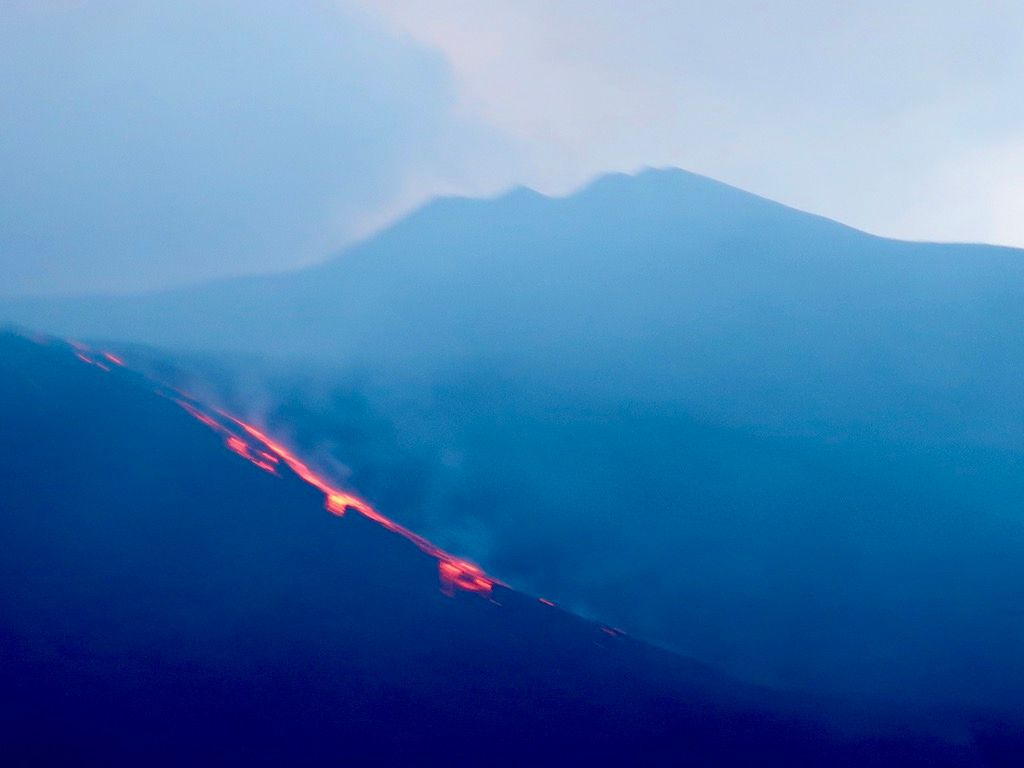
Temples in Agrigento
Our next stop was Agrigento. It was established by Greek colonists in the 5th century BC and flourished until it was partially destroyed by the Carthaginians at the beginning of the following century. We visited the Valley of the Temples with seven impressive Doric temples for Greek gods, and the archaeological museum exhibiting excavation findings.
In the nearby marina, African street vendors sold their goods. Sicily has long historical traditions of immigration, in recent times refugees who come via the island Lampedusa between Sicily and Tunisia have caused political disagreement. We spoke to locals who were tolerant if the new arrivals were self-supporting, but sceptical of giving them public welfare. We also spoke to Africans who were grateful to have found work and new opportunities in Italy.
According to one widespread theory, the Mafia originated in Sicily in the 19th century as armed groups that collected rent for landowners, they later spread in Italy and to other countries. Our knowledge of the tough guys with strong family values stems mostly from movies. During the trip in Italy, we understood that the mafia survives in new forms in the borderland between crime, corruption and business, despite decades of police pursuit and trials. A Sicilian said, "Don't be afraid, they do no harm to tourists!"
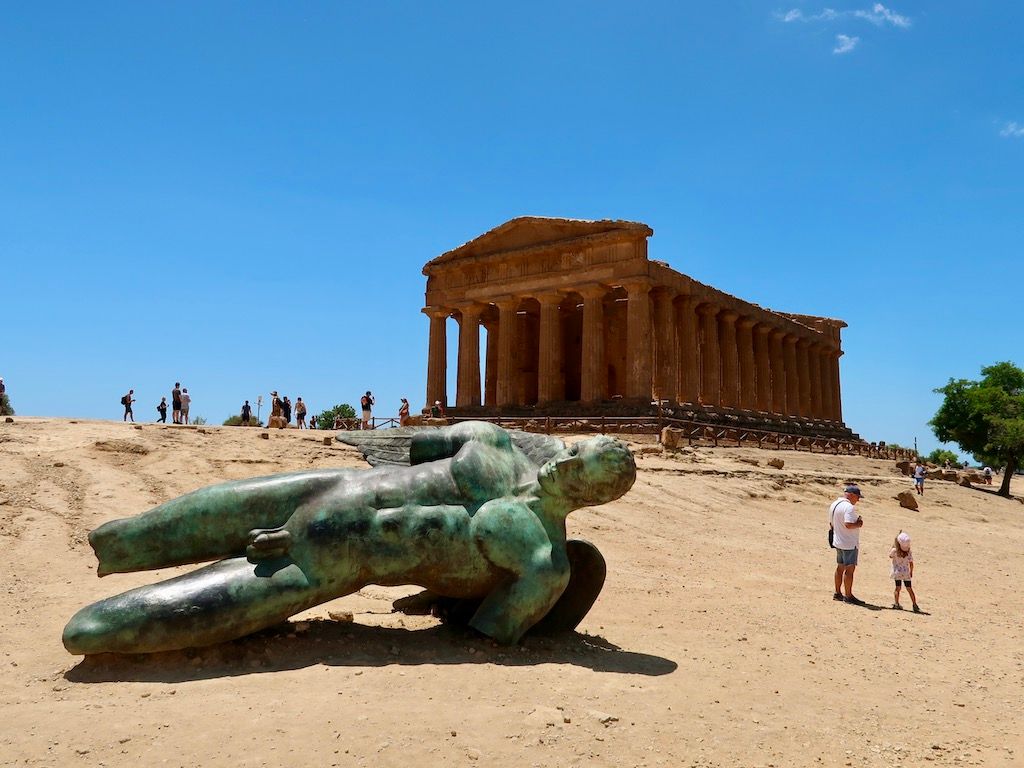
Welcoming Syracuse
Syracuse was founded in 733 BC by Greeks from Corinth and in the following centuries became the most important colony in Magna Graecia the size of Athens. Today it is a beautiful city with a welcoming atmosphere. Syracuse has good places to bathe in the sea, and the warm climate inspired us to take a swim.
We visited a museum that pays tribute to the local engineer and mathematician Archimedes from antiquity, together with the Renaissance genius Leonardo da Vinci. In the archaeological area of Neapolis we saw the remains of the mighty altar of the tyrant Hieron, a large Greek and a smaller Roman amphitheatre. The nearby Catacombs of San Giovanni were built in the late 4th century when the Emperor Constantine the Great allowed Christianity. The church ruins are still used for religious purposes and our guide was married here. She led a tour of the underground rock tombs that were cleared and used as shelters during World War II. The city's white cathedral from the 18th century in baroque style reuses a temple of Athena and its massive Doric columns.
Sicily has a tradition of marionette theatre, which among others the Vaccaro-Mauceri family in Syracuse’s Jewish quarter continues. We saw a play in several acts in Italian and understood that the knight Orlando, a beautiful maiden and a dragon that was killed were important characters. The family's museum tells the history of theatre in miniature and displays finely crafted puppets.

The trulli of Alberobello
After crossing the Strait of Messina again, our trip went northeast to Alberobello. The town is known for its smurf-like stone houses with cone-shaped roofs, that protect against rain but allow smoke to escape. These trulli were originally built without the use of mortar. According to one tradition, the style was invented when local lords in the 15th century wanted to avoid paying taxes to the King of Naples for new houses.
If inspectors came, the buildings could be quickly taken down and rebuilt when they left. We went for walks and experienced the peaceful district of Rione Aia Piccola and the tourist-busy Rione Monti. The museum in Trullo Sovrano gave a fine impression of secular and Chiesa Sant'Antonio of religious trulli style. A bike ride in the Itria Valley along small roads between stone fences showed that the tradition lives on. Old houses are restored and new ones built.
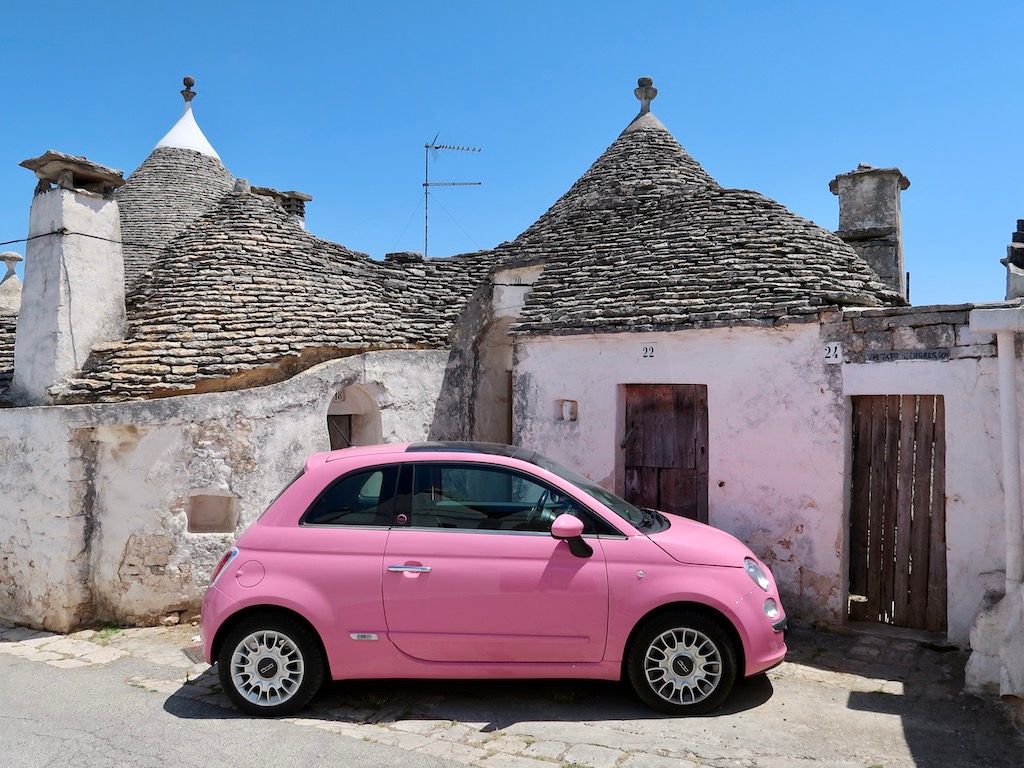
Fresh seafood in Senigallia
During a short stay in Senigallia, our camping neighbours were welcoming Italian families on a beach holiday. A restaurant with a view served a delicious menu of fresh sea food.
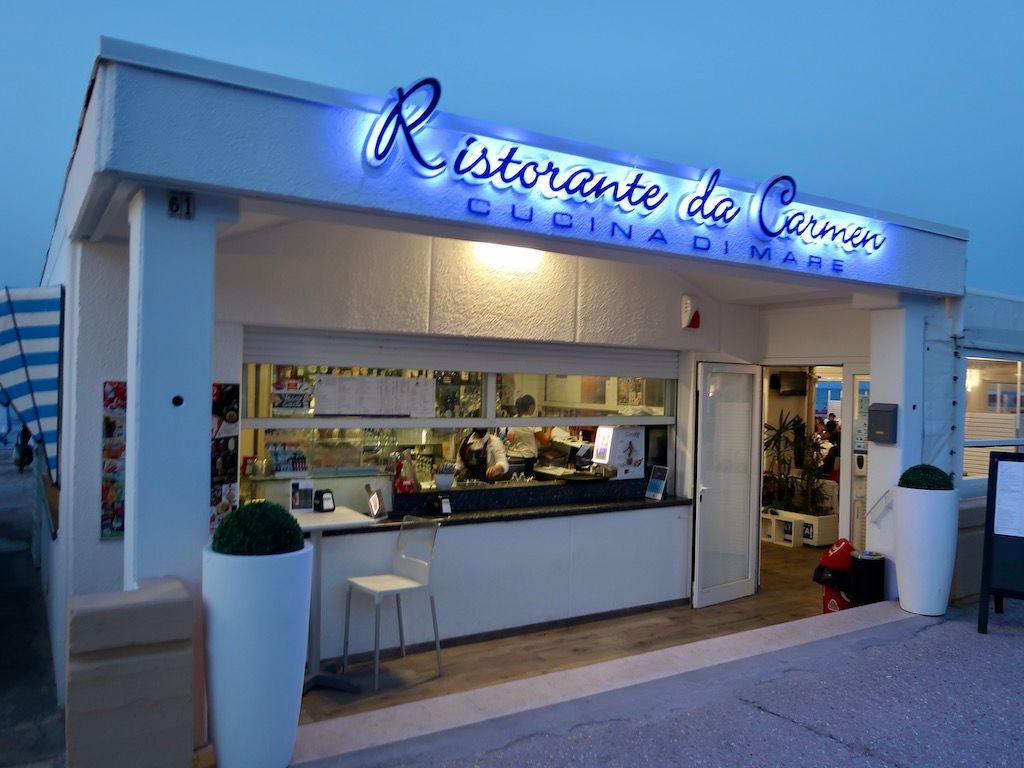
Climate protection in Venice
Venice was probably founded in the 6th century by immigrants to the islands of the lagoon. In the Middle Ages and the Renaissance, the city-state gained great power. This lasted until the latter half of the 17th century, when the influence of the Ottoman Empire grew. Venice became part of the united Italy in 1866.
In many areas, the buildings are erected on poles rammed into the ground. We experienced the canal city on bicycles, on foot and on its well-functioning route boats. We have walked over and sailed under the Rialto Bridge, which spans the Grand Canal, our first stop however was St. Mark's Square.
St. Mark's Church was built to house the evangelist's tomb after his body had been abducted from Alexandria by two Venetian merchants in 828. Mark became the city's patron saint and the lion its symbol. The mix of Byzantine, Romanesque and Gothic styles unites East and West. Above the entrance of the church stand four horse sculptures, which are copies of spoils of war from Constantinople in 1204. The church reflects the grandeur and vision of Venice.
So, does the marble building of the Doge's Palace. It was the residence of the political head of the republic and housed its government and judiciary. Venice's form of government has inspired modern democracies. The palace is a treasure trove of gilded rooms with fine art. At the end of the tour you pass the Bridge of Sighs to the gloomy prison. When we were there, the German painter Anselm Kiefer had a temporary exhibition of modern paintings in vivid dialogue with the history of the palace and the city in one of the huge halls.
The Correr Museum at the southern end of St. Mark's Square added dimensions to our understanding of Venice's history, and the visit introduced us to the Biennale, which spreads art throughout the city. The biennale has existed since 1895. We spent a couple of days visiting the Giardini park, where around 40 countries have permanent pavilions, as well as Arsenale, where the works are presented in the large halls of the former shipyard area.
The exhibitions were curated by Italian Cecilia Alemani based in New York. They featured more than 200 artists from 58 countries and their studies of humanity at a time when the species may be threatened. The themes were grave, but we met kindness and warmth in attractive surroundings. "Nice to be here and get all the positive response," said one exhibition host.
In the shop Ca'Macana we bought a carnival mask of the plague doctor with round glasses and a long beak. The clerk told us that it was in demand now due to the corona pandemic and the interest in plant medicine.
We camped on the long island Lido di Venezia. It is part of Venice's protection against the threatening combination of shrinking foundations, land sinking and rising seas. We cycled to the northern tip to see one of the gates, that have been built to reduce the risk as part of the MOSE system.
Locals in the area had divided opinions about it. An engineer said, "It has been a long time coming and very expensive to build. It will also be expensive to maintain, and the consequences for the environment are unclear.” An angler was more optimistic, "During the first year, it has worked three times. I hope it will save Venice.”
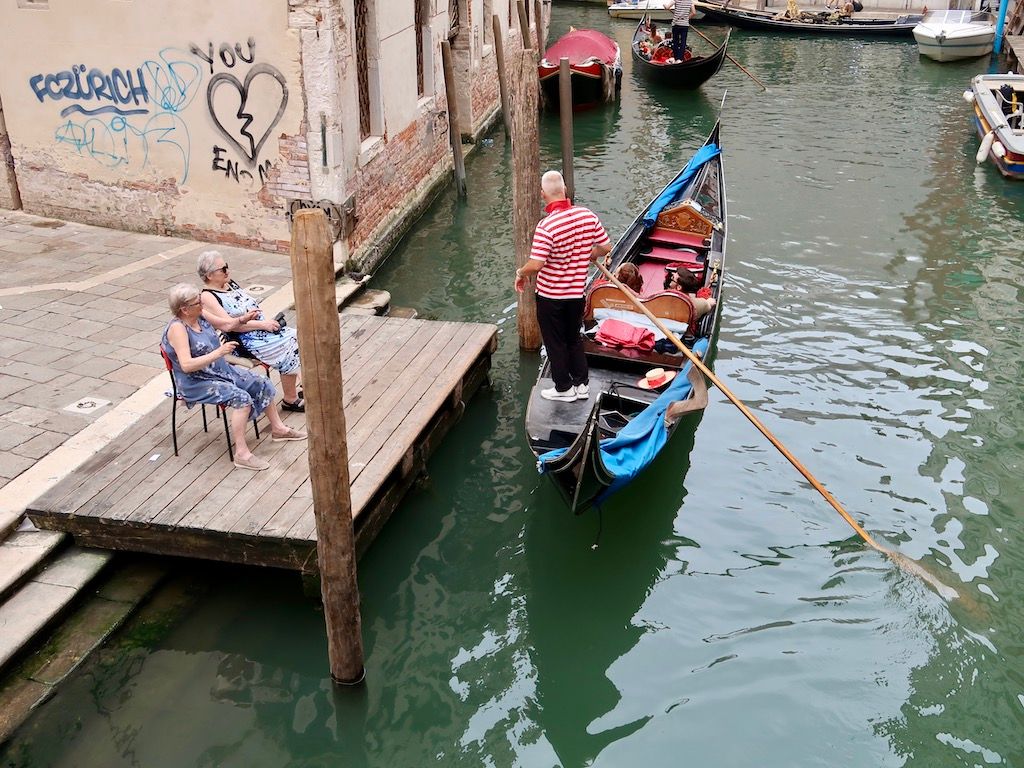
We left Italy via the Brenner Pass and with overnight stays in Lindau and Dransfeld in Germany, we reached Odense after two months full of experiences in the beautiful country.
